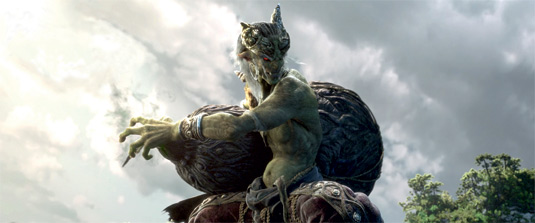Does the future of 3D lie in China? It's been on the cards for a while but things are changing very fast in the world's second largest economy.
Recently China launched the CG equivalent of Silicon Valley, The Jiangye Newtown Technology Park, to help propel the industry forward.
So far the regional government has bought 400 licenses of PipelineFX's Qube! to manage rendering needs, and forged a joint venture with Original Force to provide renders, motion capture, colour grading and 3D scanning to customers across the globe. For 3D animation ideas, see these 3D animated graduation shorts.
In total 100 companies are currently residing at the park, working across films, games, animation and new media.
Hotting up
One of those is BaseFX, a Beijing- based digital effects house set up in 2006 with the aim of serving both Hollywood and the local Chinese and Asian industries. And things are hotting up for the company, which has a close relationship with ILM.
"We're currently finishing up Monster Hunt, the biggest VFX film completed here to date, with 720 photoreal character shots," explains founder and CEO Christopher Bremble.
"Last year we worked on Captain America: The Winter Soldier, Teenage Mutant Ninja Turtles, Transformers: Age of Extinction, Black Sails, True Detective, Agent Carter, and several local films including Breakup Buddies for Ning Hao. So 2014 was a great year for us and 2015 is looking just as good."
Daily design news, reviews, how-tos and more, as picked by the editors.

But working in China isn't without its difficulties. "Budgets on Chinese films remain very challenged. Chinese films have a small number of territories to sell into and the domestic industry can't afford films heavy on high-quality visual effects. So there are a lot of films with a thousand poorly done shots," Christopher explains.
He adds, "The market place is more focused on quantity than quality, which is the inverse of the US market. That makes it hard to do business locally. The top companies, such as BaseFX and Technicolor, all rely on international clients/co-productions for a significant amount of their revenue."
Cultural differences
There are also cultural differences when it comes to process. "In China, many artists are self-taught and like to handle a shot from modelling to final comp," Christopher says.
"That's just not an efficient way to work most of the time," he adds. "The generalist approach works fantastic for the brilliantly talented artists, but the majority of artists have real weaknesses in some part of the pipeline, and those weaknesses come through when they try to work at the highest level."

That culture is changing fast, though, believes Longji Hao of OxygenTec, Pipeline FX's main reseller in the region.
"Most of China's animation companies are changing from a traditional model to streamlined development right now," he says. But they're not there yet, and Longji describes the current period as one of "transition", in which "pipelines will need to be more simplistic and practical" for a little longer.
For that reason, it would be brave for a foreign company to launch an offshoot in China right now, adds his colleague, QiHui Li. "For a purely foreign team in China, things would be difficult since they won't understand the perspective of the Chinese and the business environment," he believes. "It would be better to partner with a Chinese company first. Then they could both live and grow in the complex and expanding Chinese market."
Homegrown firms
But in all honesty, it's most likely to be homegrown firms who end up dominating that enormous market. That's certainly what Original Force believes, anyway.

Founded in 1999, the company, which works on gaming, animation and CGI production, was invited in 2011 to spend two years producing the Dreamworks TV series, Dragon: Riders of Berk.
"Then this April we revealed the first big screen project of our own," says founder Harley Zhao. And it's very much the way forward for the company as he sees it.
Brand value
"Outsourcing will be our steady foundation, but we're also trying to turn ourselves from a purely outsourcing company into a one that can add to its brand value continuously," he says.
"We've established our creative production team in both China and LA, we have the best talents in the industry, and we've got the most incredible IPs in our hands," Harley continues.
"We've kept the dream in our heart from day one and are walking on our way to achieve it. Sooner or later, we will make the world know about the most amazing animation movies that were made by Original Force."
Liked this? Read these:

Tom May is an award-winning journalist specialising in art, design, photography and technology. His latest book, The 50 Greatest Designers (Arcturus Publishing), was published this June. He's also author of Great TED Talks: Creativity (Pavilion Books). Tom was previously editor of Professional Photography magazine, associate editor at Creative Bloq, and deputy editor at net magazine.
